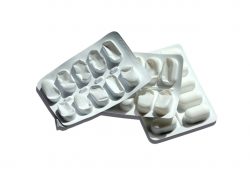While nowhere near as “popular” as oxycodone or Vicodin, dihydrocodeine appears in more than a few prescription-based opiate drugs. Dihydrocodeine produces pain-relieving effects along the lines of codeine and works well for treating a range pain-related conditions.
This drug’s pain-relief properties also come with a risk for abuse and addiction, regardless of whether its used for medicinal or recreational purposes. While effective as a treatment drug, a developing drug abuse problem may well require some form of dihydrocodeine addiction treatment when left to its own devices.
For these reasons, it’s important to monitor drug intake closely as abuse practices can develop over time without a person even knowing it.
Call our toll-free helpline at 800-442-6158 Who Answers? to ask about opiate addiction treatment options.
Brand Names
According to the Food & Drug Administration, dihydrocodeine derives from codeine and produces effects similar to codeine. Dihydrocodeine-based drugs belong to the Schedule III and Schedule IV class of controlled substances, both of which carry a risk for abuse and addiction.
Dihydrocodeine produces short-acting, rapid onset effects. As a member of the codeine family, dihydrocodeine acts as a main ingredient in several types of prescription opiate drugs.
Brand names for dihydrocodeine include:

Dihydrocodeine is often combined with aspirin to enhance the effects.
- Panlor DC
- Drocode
- Parzone
- Trezix
- Didrate
- Paramol
- Dico
- Hydrocodin
These brands differ based on strength of the drug and added ingredients, such as aspirin and acetaminophen. Adding a non-opiate pain reliever helps to enhance the effects of dihydrocodeine without increasing the opiate concentration.
Street Names
Dihydrocodeine street names can be hard to decipher, especially for unsuspecting friends and loved ones. Teenagers in particular use street names on a regular basis, partly to be “cool” and partly to disguise drug-using activities.
Common street names for dihydrocodeine include:
- DHC
- DF
- DF118
With codeine as the main ingredient, dihydrocodeine street names may reference the codeine component and include the following:
- Cody
- Schoolboy
- Empi
Dihydrocodeine Uses
Dihydrocodeine can be used as an analgesic and as a cough suppressant. Depending on any one drug’s formulation, dihydrocodeine can produce fixed dose or controlled-release effects.
As a pain treatment, tablet and capsule forms containing 15 to 16 milligram doses are typically prescribed. Pain relievers may also contain non-opiate agents, such as aspirin, ibuprofen or acetaminophen. These additives work to enhance dihyrocodeine’s effects.
As a cough suppressant, dihydrocodeine may be combined with decongestant and antihistamine agents as well.
According to the British Journal of Clinical Pharmacology, in doses of up to 2,500 milligrams, dihydrocodeine can also be used as a replacement therapy to treat cases of chronic heroin addiction. Replacement therapies help to wean addicts off heroin while relieving uncomfortable withdrawal aftereffects.
How Does Dihydrocodeine Work?
As an opiate-based drug, dihydrocodeine stimulates dopamine, norepinephrine and serotonin production, all of which are essential brain neurotransmitter chemicals. These interactions cause chemical activities in the brain and central system to slow down.
In effect, slowed chemical activity slows down nerve signal transmission rates, which in turn blocks incoming pain signals from reaching the brain.
For information on opiate addiction treatment programs, call our helpline at 800-442-6158 Who Answers? .
What are the Signs of Prescription Drug Abuse in Young People?
Dihydrocodeine Side Effects
Dihydrocodeine side effects can take any number of forms depending on any one person’s physical make-up. Side effects develop out of the drug’s interference with normal chemical processes in the body.
According to the Utah Department of Health, dihydrocodeine side effects typically take the form of:
- Constipation
- Nausea
- Vomiting
- Urinary retention
- Low blood pressure
- Sweating
- Itching
Dihydrocodeine Dangers
Dihydrocodeine’s ability to slow chemical activities throughout the brain and central nervous system inevitably slows down the body’s major systems. In large enough dosage amounts, dihydrocodeine can overpower the brain’s ability to maintain one or more systems.
When this happens, bodily functions shutdown altogether. These conditions can bring on an overdose episode.
More often than not, the body’s respiratory system is the first to be affected. Someone having difficulty breathing or experiencing slowed breathing rates may well be overdosing on the drug. These conditions can quickly lead to death and warrant immediate medical attention.
Abuse Potential
Tolerance Level Changes
Dihydrocodeine abuse progresses along the lines as any other form of opiate abuse. Gradual changes in tolerance levels become the first real warning sign of a developing drug problem, according to Columbia University.
Tolerance level changes take shape as neurotransmitter-producing cells start to take on structural damage from having to work harder than usual. Damaged cell sites become less sensitive to dihydrocodeine’s effects so a person has to take larger doses in order to experience the same desired effects.
In effect, rising tolerance levels will continue for as long as a person keeps using the drug.
Physical Dependence

Low energy levels and mental confusion are common dihydrocodeine withdrawal symptoms.
Physical dependence develops out of the ongoing effects of dihydrocodeine on the brain. In essence, prolonged or excess use of this drug turns the brain’s chemical system into a dihydrocodeine-dependent environment.
As tolerance levels increase, physical dependence becomes more severe. Once a person starts experiencing withdrawal effects, a physical dependence is at work. Withdrawal effects typically take the form of:
- Anxiousness
- Low energy levels
- Mental confusion
- Depression
- Irritability
Addiction
Someone addicted to dihydrocodeine has lost the ability to control his or her drug-using behaviors. In effect, the drug’s effects have warped the brain’s reward system, an area that regulates thinking, emotion and behavior.
Before long, a person’s sense of security and control comes to depend on dihydrocodeine’s effects to the point where he or she can no longer cope with everyday life without the drug. Signs of a developing addiction include:
- Money problems
- Relationship problems
- Problems on the job
- Legal problems
- Decline in personal grooming and hygiene
Dihydrocodeine Addiction Treatment
A dihydrocodeine addiction can develop without a person’s even knowing it. Once his or her life starts to fall apart, the need for some form of treatment help becomes increasingly apparent.
While it is possible to stop using dihydrocodeine on one’s own, the psychological aftereffects of the drug make ongoing abstinence difficult to maintain. Dihydrocodeine addiction treatment programs provide you with the type of supports and guidance needed to break this drug’s hold over your life once and for all.
If you’re struggling with a dihydrocodeine addiction problem and don’t know where to turn, please feel free to call our helpline at 800-442-6158 Who Answers? to speak with one of our addiction counselors.











